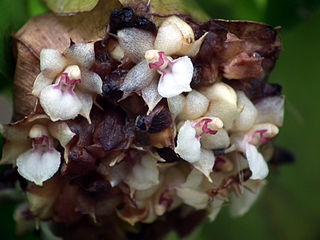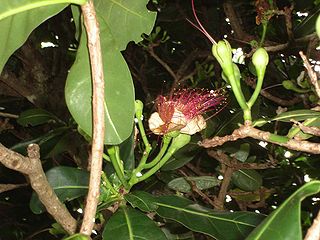
Antidesma is a genus of tropical plant in the family Phyllanthaceae formally described by Linnaeus in 1753. It is native to tropical Africa, S + E + SE Asia, Australia, and various oceanic islands. The greatest diversity occurs in Southeast Asia.

Mallotus is a genus of the spurge family Euphorbiaceae first described as a genus in 1790. Two species are found in tropical Africa and Madagascar. All the other species are found in East Asia, the Indian Subcontinent, Southeast Asia, eastern Australia, and certain islands of the western Pacific. The genus has about 150 species of dioecious trees or shrubs.

Agrostophyllum is a genus with about ninety species from the orchid family (Orchidaceae). The genus name is derived from the Greek words agrostis ("grass") and phyllos ("leaf"), referring to the grass-like appearance of the leaves of some species.
Trigonostemon is a plant genus of the family Euphorbiaceae and the sole member of its tribe (Trigonostemoneae). It was first described as a genus in 1826. It is native to Southeast Asia, southern China, the Indian Subcontinent, Queensland, and a few islands in the western Pacific.
Melanolepis is a plant genus of the family Euphorbiaceae, first described as a genus in 1856. It is native to Southeast Asia, New Guinea, and some islands of the western Pacific.
- Melanolepis multiglandulosa(Reinw. ex Blume) Rchb. & Zoll - Nansei-shoto, Mariana Islands, Solomon Islands, Bismarck Archipelago, New Guinea, Maluku, Sulawesi, Philippines, Lesser Sunda Islands, Java, Sumatra, Borneo, Thailand, Malaysia, Taiwan
- Melanolepis vitifolia(Kuntze) Gagnep. - Vietnam, Cambodia

Dimorphocalyx is a genus of plants under the family Euphorbiaceae first described as a genus in 1861. It is native to Southeast Asia, Hainan, India, Sri Lanka, New Guinea, and Queensland.

Homalanthus is a plant genus of the family Euphorbiaceae first described as a genus in 1824. It is the only genus in subtribe Carumbiinae. The genus is native to tropical Asia, Australia, and various islands in the Pacific.
Pimelodendron is a plant genus in the family Euphorbiaceae first described as a genus in 1855. It is native to insular Southeast Asia, Thailand, Papuasia, and Queensland.

Aporosa is a genus of flowering plant belonging to the family Phyllanthaceae first described as a genus in 1825. It is native to China, the Indian Subcontinent, Southeast Asia, Papuasia, and Queensland.

Bridelia is a plant genus of the family Phyllanthaceae first described as a genus in 1806. It is widespread across Africa, Australia, southern Asia, and various islands of the Indian and Pacific Oceans.

Cleistanthus is a plant genus of the family Phyllanthaceae, tribe Bridelieae, first described as a genus in 1848. It is widespread in much of the Old World Tropics in Asia, Africa, Australia, and various oceanic islands. Cleistanthus collinus is known for being toxic and may be the agent of homicides or suicides.

Breynia is a plant genus in the family Phyllanthaceae, first described in 1776. It is native to Southeast Asia, China, the Indian Subcontinent, Papuasia, Australia, and the island of Réunion.

Pothos is a genus of flowering plants in the family Araceae. It is native to China, the Indian Subcontinent, Australia, New Guinea, Southeast Asia, and various islands of the Pacific and Indian Oceans.

Barringtonia is a genus of flowering plants in the family Lecythidaceae first described as a genus with this name in 1775. It is native to Africa, southern Asia, Australia, and various islands of the Pacific and Indian Oceans. The genus name commemorates Daines Barrington.

Anodendron is a genus of plant in the family Apocynaceae first described as a genus in 1844. It is native to China, the Indian Subcontinent, Southeast Asia, New Guinea, and some islands of the western Pacific.
- Anodendron affine(Hook. & Arn.) Druce - China, Japan, Ryukyu Islands, Philippines, Vietnam, Laos, Thailand, Myanmar, Bangladesh
- Anodendron axillareMerr. - Philippines, Borneo, W Malaysia, Java, Sumatra
- Anodendron benthamianumHemsl. - Taiwan
- Anodendron borneense(King & Gamble) D.J.Middleton - Borneo, Palawan
- Anodendron candolleanumWight - Thailand, W Malaysia, Borneo, Java, Sumatra, Philippines
- Anodendron coriaceum(Blume) Miq. - Thailand, W Malaysia, Borneo, Java, Bali, Lombok, Timor, Flores
- Anodendron gracile(King & Gamble) D.J.Middleton - Borneo, Palawan, W Malaysia
- Anodendron howiiTsiang - Guangxi, Hainan
- Anodendron nervosumKerr - Yunnan, Assam, Laos, Thailand, Vietnam, Java, Sumatra
- Anodendron oblongifoliumHemsl. - Borneo, Philippines, Maluku, New Guinea, Bismarck Archipelago, Solomon Islands, Vanuatu
- Anodendron paniculatum(Roxb.) A.DC. - India, Bangladesh, Sri Lanka, Andaman & Nicobar Is, Malaysia, Indonesia, Philippines
- Anodendron pauciflorumHook.f - Borneo, W Malaysia, Sumatra
- Anodendron punctatumTsiang - Cambodia, Thailand, Guangxi, Hainan, Sichuan
- Anodendron seramenseD.J.Middleton - Maluku
- Anodendron tubulosum(Ridl. ex Burkill & M.R.Hend.) D.J.Middleton - W Malaysia, Sumatra
- Anodendron whitmoreiD.J.Middleton - Maluku, New Guinea, Solomon Islands
- Anodendron wrayiKing & Gamble - W Malaysia

Scindapsus is a genus of flowering plants in the family Araceae. It is native to Southeast Asia, New Guinea, Queensland, and a few western Pacific islands. The species Scindapsus pictus is common in cultivation.

Thelasis, commonly known as fly orchids, is a genus of flowering plants from the orchid family, Orchidaceae. Plants in this genus are usually epiphytes, sometimes lithophytes or rarely terrestrials. Some species have pseudobulbs with up to three leaves, whilst others have several leaves in two ranks. A large number of small, white or greenish yellow flowers are borne on a thin, arching flowering stem. There are about thirty species, distributed from tropical and subtropical Asia to the southwest Pacific.

Myxopyrum is a plant genus native to India, southern China, Southeast Asia and New Guinea. There are at present 4 recognized species:
Micrechites is a genus of flowering plants in the family Apocynaceae, first described as a genus in 1857. It is native to China, the eastern Himalayas, Southeast Asia, Papuasia, and Queensland.

Decaspermum is a genus of the botanical family Myrtaceae, first described as a genus in 1776. It is native to China, Southeast Asia, Queensland, and various islands of the Pacific Ocean.
















